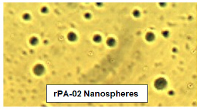Consisting of biodegradable polymer nanospheres using PNS technology for anthrax vaccines
 Anthrax remains a significant bioterrorism threat to the United States and its allies. The current anthrax vaccine, BioThrax®, requires at least five injections at 0 and 4 weeks and then 6, 12 and 18 months followed by annual boosters. There are concerns about the high frequency and extended vaccination schedule, adverse reactions, product stability and shelf life of the current version of the anthrax vaccine.
Anthrax remains a significant bioterrorism threat to the United States and its allies. The current anthrax vaccine, BioThrax®, requires at least five injections at 0 and 4 weeks and then 6, 12 and 18 months followed by annual boosters. There are concerns about the high frequency and extended vaccination schedule, adverse reactions, product stability and shelf life of the current version of the anthrax vaccine.
Second-generation anthrax vaccines that utilize highly purified recombinant protective antigen (rPA) are being developed to reduce immunization frequency, dosing schedules, and adverse side effects. Encapsulation of the antigen in nanoparticles has been shown in different studies to improve the immunogenicity of the vaccine (Westwood et al, 2005) and eliminate the need for cold chain for vaccine preservation (Sloat et al, 2010).
Biodegradable Polymer Vaccine Adjuvant
Microspheres, comprised of biodegradable hydrophobic copolymers, appear to have an adjuvant effect on microencapsulated anthrax rPA, possibly caused by its controlled release and/or immune stimulation of the dendritic cells by the copolymer (Flick-Smith et al., 2002). While highly promising, the hydrophobic microspheres are manufactured from organic solvents.
 Aphios has utilized PNS technology to produce a nano encapsulated rPA vaccine using supercritical fluids in a bench-scale SuperFluids™ PNP apparatus. Preparations were made by varying the components and characterized for rPA content and mean particle size.
Aphios has utilized PNS technology to produce a nano encapsulated rPA vaccine using supercritical fluids in a bench-scale SuperFluids™ PNP apparatus. Preparations were made by varying the components and characterized for rPA content and mean particle size.
Particle sizes of the polymer nanospheres formed encapsulating rPA ranged from 370 nm to 1.54 µm. The data also shows that all three preparations contained rPA, indicating that the encapsulation process did not destroy the antigen. A photomicrograph of rPA-02 nanoparticles shows that the particles are mostly uniform in size with a few variants.
In Vivo Immunization and Efficacy Testing
rPA polymeric nanospheres (rPA-01) were lyophilized and stored at 5ºC during transportation and storage. Lyophilized rPA-01 was formulated with 20% alhydrogel (v/v) in PBS to produce a final rPA concentration of 200 µg/mL. Similarly, rPA alone was formulated with 20% alhydrogel (v/v) in PBS to produce a final rPA concentration of 200 µg/mL, as a control.
Female adult A/J mice (Harlan, UK) were immunized once with a 20 µg dose in 0.1 mL intra-muscularly for either preparation (groups of 5). Response to immunization was monitored by bleeding the mice on day 14 and measuring IgG titers to rPA in serum samples by standard ELISA.
Mice were then challenged on day 21 with 103 MLD equivalent to 106 colony forming units (cfu) of Bacillus anthracis STI strain spores intraperitoneally (i.p.). Survival was monitored over the subsequent 14 days.
The results of the preliminary study indicate the following:
- All formulations tested were immunogenic – both encapsulated and unencapsulated.
- rPA-01 produced 22% higher IgG titer, suggesting that it is more immunogenic than the positive control (free rPA).
All the vaccinated mice survived, indicating that the rPA-01 was fully protected and that immunogenicity for the encapsulated antigen was preserved. Since this is the first time that rPA has been encapsulated in biodegradable polymer nanospheres by the PNS process, we are encouraged by the successful results of this challenge.
Benefits and Advantages
- Elimination of the problems associated with the traditional methods of nanoencapsulation, such as the use of organic solvents
- Acceleration of the development of rPA as a second-generation vaccine that will improve immunogenic response, reduce immunization frequency and prolong shelf life